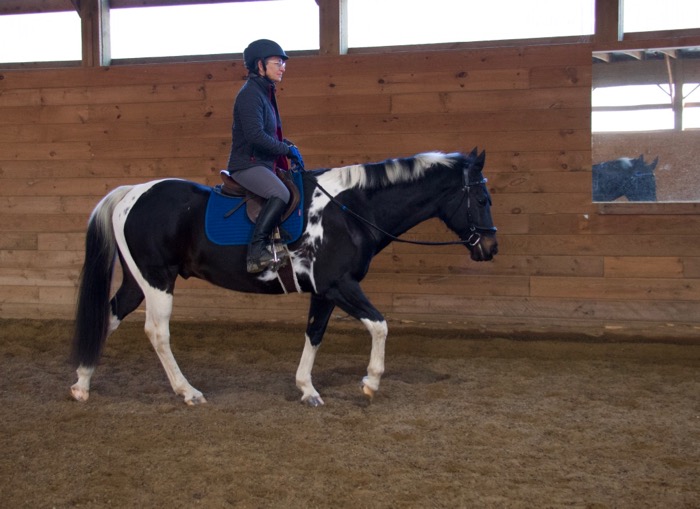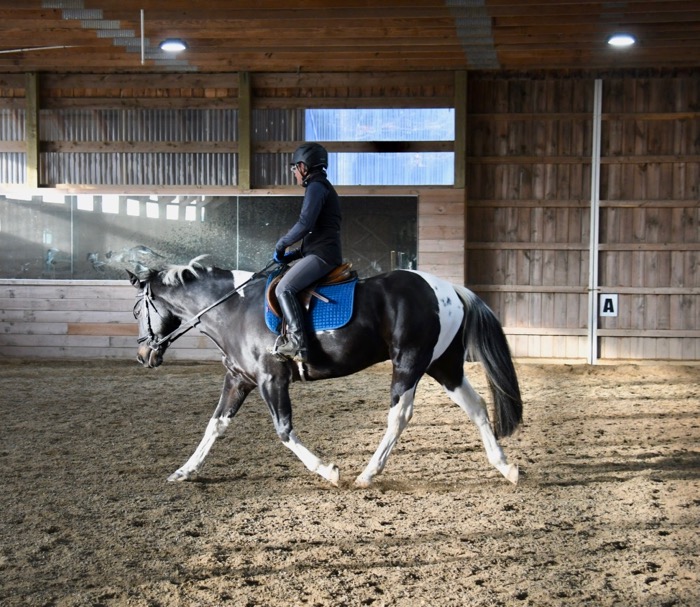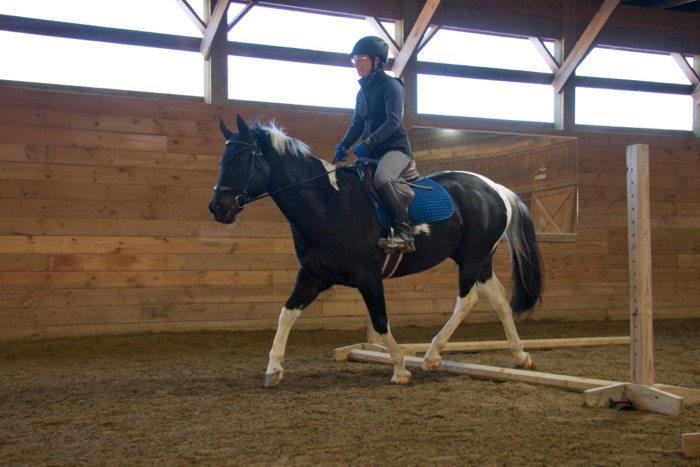I follow Denny Emerson on Facebook. He’s a true horseman. Not only is he a gold medal Olympian (in eventing when it was long-form), but he has also completed the Tevis cup. He’s full of wisdom and opinions. I love that he writes about how he’s become more patient, empathic and kinder to his horses over time. One of the things that he advocates, both for training and for fitness, is to get on your horse and walk. I agree completely and posted on his page that a walk warmup is essential for lubrication of the synovial joints, too. (Some joints are lubricated, those are the synovial ones, including the hocks and stifles. Some are not, like the sacroiliac.) This advice is something that I’ve heard from trainers that I respect. Someone posted a reply to my comment saying that I was wrong and that the warmup is for the muscles, ligaments and tendons. That the fluid in its sac is inert. I don’t like being told that I’m wrong, but I realized that I honestly didn’t know enough about synovial joints to counter the comment. I have since read up. I was right, and now I know why! I’ll share what I’ve learned here.
The idea that the fluid in the synovial joint is static bothered me. It didn’t make sense. The entire body is a living and complex organism. Synovial fluid is a viscous mix that includes hyaluronic acid, lubricant, collagenases and proteinases. The synovial membrane produces these materials on an on-going basis. Some of the fluid floats freely in the sac and some is absorbed in the cartilage, and then released during movement. As the joint is engaged, the fluid circulates, keeping the bones from grinding against each other and also acting as a shock absorber. Waste products are removed and oxygen and nutrients are replenished. If you were to remove all of the synovial fluid (this has been done in goats), it takes four days for it to return to normal. So, rather than being an inert ball of fluid, think of the synovial joint as being in constant flux. What keeps it healthy is movement.
If you were to take your horse out of a stall and go right into a trot, that synovial fluid would not have had a chance to move out of the cartilage. Waste products would not have been transported out of the sac. The joints will be at risk. That is why it is so important to do this. Walk.

Then walk some more. I keep track and go a half-mile, or 10 to 15 minutes. I can tell when Tonka’s joints are warmed up – his walk starts to swing. The strides get bigger (not faster.) Then we’re ready to do this. Stretching, which warms up the rest of him.

Then, and only then, do I ask more of my horse and his joints.

The added benefit is that my own joints have time to warm up – after all, I have synovial joints, too! When I warmup along with my horse, I’m a better rider. Here’s a good article about how dancers get moving before they really get moving. (It includes current research on stretching, too – advice that I need to pay attention to!)
Do you have a warmup routine for your horse and/or you? Tell me in the comments!


This is a wonderful article !!! Thank you !!!
🙂
I enjoyed this article, had no idea there were waste products and all that, didn’t realize warmup was also for the synovial fluid as well as for everything else it helps. I trail ride and have been “preaching” warmup and cool down for years to riders who won’t listen. Frustrating.
One reason why you have such soundness longevity with your horses, even with the gymkhana and trail riding! Keep “preaching”!
Same here; walk (on free rein or neck rein with no contact with mouth, feet out of stirrups) for at LEAST ten minutes. While Lance walks, I go through some leg position changes to make sure I’m sitting deep and even on my seat bones, and my hips are free to lift my legs away from the saddle.
And it sets the tone for the ride, too. Stella will benefit from that. Start with a calm attitude and you get flow 🙂
Good blog! I try to do 20 min of walk. The good weather is easy, take a walk around the field and pond then head for the ring or better yet do my flat work in the field! The winter is a little harder. I know it’s hard to walk when it’s cold and your in the indoor. I use the time to warm up my mind and forget about the hectic day I’ve had and settle and relax my brain. My horses so quickly key in to my tenseness. My horses also need time to warm up thier minds. Are they listening and in front of my leg and relaxed with an increasingly swinging and forwalk walk? Is one shoulder stiffer than the other or one hind leg not stepping under all the way that it should? Are they more responsive to one leg aid more than the other? The answers to all these questions determine the rest of my warmup and my schooling session.
Sorry to ramble on but I am soooo tiered of watching riders come into the indoor on cold horses and picture up a trot or canter right away. Can you tell it is a pet piece of mine
Terry thank you for all your insights! Stay warm in Maine, my sister who lives up there is saying this is an easy winter. Unfortunately she is used to much worse!
My pet peeve is people who do no warmup before letting their horses run like mad on a lunge line – tight circles, bursts of speed, bucking. All on “cold” joints.
In the human physical therapy world I worked in, the mantra was “motion is the lotion”, and it was all about the joints. Warming up muscles before stretching was important, but the joint activation was primary.
It just makes sense.
Thanks for always putting your best facts together for your readers. I value your information.
Love that “motion is the lotion!”
Thank-you for validating the walk. We start loose rein 8-10 minutes followed by another 10 with shortened reins. It’s sometimes boring, you can’t wait to get started but especially in the colder weather I feel like it will pay dividends. I love all the comments below supporting this practice.
It’s boring especially in winter, going around and around the arena. That’s why I use a timer and don’t allow myself to rush it.
I’ve also always been a walk to warmup person, for myself as much as my horses. Your post is making me wonder though.. if motion is what causes things to loosen up, would the increased motion of the trot actually produce results faster? Just trying to suss out the physiology of it.. Do you know of any studies that have been conducted on this topic?
It takes time for the joints to lubricate. Go faster and all you’re doing is grinding that cartilage, so stick to what you’ve been doing 🙂
Great article! Thank you
Also loved the one regarding horse’s eyesight!
Thanks for the comment. It’s good to hear that what I write is helpful.
this is amazing!!!!!!!!!!!!!!!